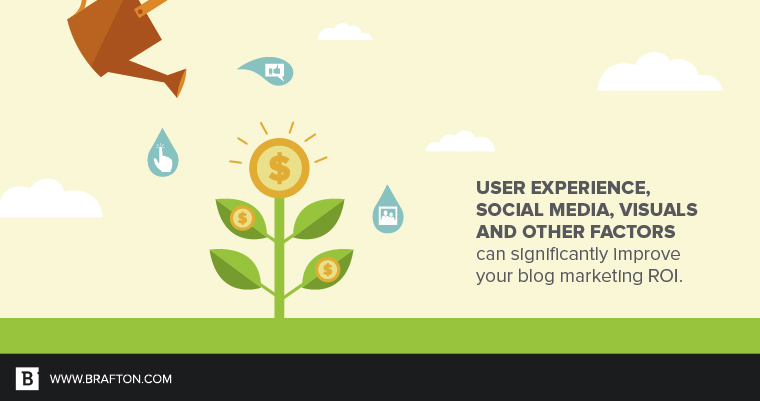You research. You write. You publish.
And once your blogs are up and running, you sit back and watch the views, clicks, leads and ROI roll in.
But wait a minute. After all the time, money and energy you put into creating your blogs, you’re not seeing the results you had hoped for!
What gives?
You know you’ve nailed the content in terms of giving prospects the information they need. But don’t forget about other factors that can contribute to your lack of blog ROI.
Well, first things first: Your blog isn’t meant to bring in a ton of sales or leads for your brand, so you shouldn’t expect that from it. If you do, you’re just setting yourself up for disappointment.
However, your blog will help increase your search exposure and serve as an initial “awareness” step that leads to those conversions, sales and leads further down the road. So that’s where your mindset should be when it comes to your blog. Treat it as a tool that helps you get the job done, not one that gets the job done completely on its own.
Now that we’ve settled that, there are several aspects you may be overlooking when it comes to your blog strategy, and knowing where to start can set you on the path to building that valuable brand awareness you seek.
Put yourself in the user’s shoes
You may be delivering the content your target audience wants, but if you’re not taking your users’ experience on your blog into consideration, you’re not going to get anywhere.
After all, 70 percent of prospects rely more on a brand’s blog rather than ads to learn about a company. So you only stand to benefit if you make the user experience a focal point of your blog strategy. Ask yourself the following questions to find out where you should improve your UX:
- Is the right information standing out? You want to make the key takeaways of your blog easy to identify and consume. Using bold formatting as well as bullet or numbered lists sets th e vital data apart for your readers.
- Are you using the right features? Using video and images in your blog can massively increase engagement, as much as 650 percent! If you’ve got visual content, use it. It will make the information presented in these formats easier to digest and turn your blogs into awareness machines.
- Are your CTAs and other features standing out? Your blog content may be great in terms of providing information, but if you leave out CTAs, then you stand no chance of readers moving on to the next step. Action-oriented language and contrasting colors are great for making CTAs pop. Also, take a look at ads, menus, buttons and other features. Are they being used correctly without overpowering the content? Getting these elements right is crucial for a successful blog, so don’t overlook them.

Turn old into new
While producing new and informative content can bring you traffic and build awareness, it’s also beneficial to dig back into your content archive and take another look at past high-performing pieces. Whether it’s old blog posts, videos, infographics or other content, consider repurposing your materials into something new for your audience.
Say, for example, you have an infographic from way back when that got a lot of views. Why not turn it into a blog? Or maybe you have a blog post that got tons of clicks and engagement, but it’s a bit outdated. Update the information and turn it into guide, eBook or video.
By repurposing your old, successful pieces into new resources, you get another chance to reach your readers with content you already know works. (Bonus: A lot of the work is already done!) Check out our repurposing eBook for more guidance:

Be a social butterfly
Your blog content should not be limited to just your website. Make use of your social networks to increase engagement and reach more prospects.
Through social media, you’re able to distribute content to your followers, but more importantly, if you create and lead a conversation around your blogs, you can extend your social reach even further. When posting a blog on a social site, encourage readers to contribute to that conversation by asking a question or stating a viewpoint. People love to share their opinions, so tap into that by enticing them to chime in on what you’ve written.
Social ads are another effective way to promote your blogs. To see success from social ads, monitor the conversations and see which kinds of content your audience is engaging with. Based on that data, you can promote your blogs and even target specific prospect groups to ensure your content reaches the right people.
Curate creatively
You definitely want people coming to your blog to read your content. But did you know using a mix of your content and other pieces from thought leaders can significantly improve your strategy? Curating content is a great way to not only establish valuable working relationships, but it also builds your authority in your sphere.
Not convinced? Consider the following when it comes to using curation in your strategy:
Collecting and promoting content from other leading sources helps fill in any gaps of information you may be missing.
Curating pieces of content from additional sources doesn’t require as much time and effort on your part. Simply put, you get more out of curation than you put into it.
You can use curation to support your message and lend even more authority to your conversation, helping your brand become more trustworthy to readers.
News that’s fit to email
It would be great if your prospects had the time to go to your website every day and read the latest blogs you’ve written, but in today’s world, that’s not the reality. So why not make it easier for your target audience to consume your content by sending out a newsletter with your most recent and most compelling pieces?
The timing of a newsletter should be determined by your audience – but weekly or bi-weekly is a good starting point. You want to include a roundup of your latest blogs with short summaries for each, or include industry and business updates, and then encourage recipients to read the content on your website. You can also add personalized elements such as the recipient’s name or content based on where they are in the journey in your email newsletters, which really can’t be done on your website or social channels.
Your blogs are for “micro” conversions, such as signups, asset downloads and site traffic. Keeping this in mind is key to bringing in that traffic that will boost your brand awareness and turn your blog into one of your most powerful marketing tools.
If you’re seeing less-than-stellar data when it comes to your blog performance, don’t be disappointed – make a change. By following these best practices and having some patience, you’re sure to improve your marketing ROI and turn your blog into a valuable resource for your target audience.





